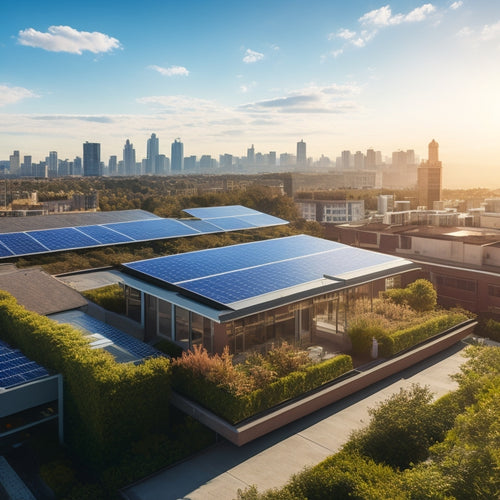
Choosing the Right Flat Roof Solar Mounting System
Share
When choosing a flat roof solar mounting system, you'll need to assess your roof's condition, including its surface damage, structural integrity, and load capacity. You'll also need to optimize solar panel orientation for maximum energy output, taking into account factors like shading, tilt angle, and roof pitch. Additionally, you'll need to decide between ballasted and anchored systems, evaluating factors like cost, durability, and environmental impact. As you review your options, be sure to take into account roof penetration choices, material compatibility, and compliance with local building codes. By carefully reviewing these factors, you'll be able to make an informed decision that meets your unique needs and sets you up for long-term success.
Key Takeaways
- Assess the roof's condition, material, and load capacity to ensure a secure and watertight installation of the solar mounting system.
- Optimize solar panel orientation and tilt angle to maximize energy output, considering shading, roof pitch, and local building codes.
- Choose between ballasted and anchored systems based on roof type, local codes, and system efficiency, considering upfront costs and long-term durability.
- Evaluate the total cost of ownership, including installation, maintenance, and energy savings, to ensure a cost-effective and sustainable solution.
- Ensure compliance with local building codes, safety standards, and zoning laws to avoid legal issues and ensure a safe and efficient system.
Assessing Your Roof's Condition
Your roof's condition plays a critical role in determining the feasibility of a flat roof solar mounting system installation. You must evaluate its current state to guarantee a successful and efficient system. Start by inspecting your roof's surface for any signs of damage, decay, or wear.
Check for cracks, blisters, or soft spots, as these can compromise the structural integrity of your roof and affect the mounting system's performance.
Regular roof maintenance is essential to extend the lifespan of your roof and the solar mounting system. Weather impacts, such as heavy rainfall, high winds, and extreme temperatures, can cause significant damage to your roof if not properly maintained.
Ascertain your roof is watertight and can withstand harsh weather conditions. Also, consider the roof's age, material, and existing obstructions, such as skylights, vents, or HVAC units, which may affect the installation process.
Understanding Solar Panel Orientation
Ideal solar panel orientation is vital for maximizing energy output and guaranteeing the overall efficiency of your flat roof solar mounting system. When you're designing your system, you'll need to take into account the direction and angle of your solar panels to optimize solar exposure.
In the northern hemisphere, a south-facing orientation is ideal, as it receives the most direct sunlight throughout the day. However, you may need to adjust this orientation based on your roof's specific conditions, such as shading from nearby structures or trees.
Proper panel alignment is also significant. Tilt angles between 10° and 30° are typical for flat roofs, as they allow for effective snow shedding and cleaning.
You'll need to confirm that your panels are aligned with the roof's pitch and azimuth to maximize energy output. Additionally, take into account the row-to-row spacing and panel layout to minimize shading and guarantee even solar exposure.
Ballasted Vs. Anchored Systems
What's the best way to secure your solar panels to the roof - with a ballasted system or an anchored one? This decision will impact your system's efficiency and installation costs.
Ballasted systems use weights to hold the solar panels in place, typically concrete or stone, which are evenly distributed across the roof. This approach eliminates the need for roof penetrations, reducing the risk of leaks and structural damage.
On the other hand, anchored systems use mechanical fasteners to secure the solar panels to the roof, providing a more rigid attachment.
Both installation techniques have their advantages. Ballasted systems are generally faster to install and more cost-effective, but they can be heavier, which may require additional structural support.
Anchored systems provide a more secure attachment, but they require more labor-intensive installation and may void your roof's warranty.
When choosing between these systems, consider factors like roof type, local building codes, and system efficiency. By selecting the right system, you'll guarantee a safe, efficient, and cost-effective solar panel installation.
Evaluating Structural Integrity Needs
When evaluating a flat roof solar mounting system, you'll need to assess the roof's load capacity to guarantee it can support the weight of the solar panels, mounting hardware, and any additional components.
You must also verify that the system complies with local building codes and regulations, which may vary depending on your location.
Roof Load Capacity
Before installing a flat roof solar mounting system, you must evaluate the roof's structural integrity to affirm it can support the additional weight of the solar panels and mounting hardware.
This involves calculating the roof load capacity, which is the maximum weight the roof can handle without compromising its structural integrity.
You'll need to take into account factors such as the weight of the solar panels, mounting hardware, and any other equipment that will be installed on the roof.
You'll also need to assess the roof's material compatibility with the mounting system to guarantee a secure and durable installation.
Load distribution is another critical factor, as it affects how the weight is dispersed across the roof. A uniform load distribution is essential to prevent concentrated stress points that can lead to structural damage.
Building Code Compliance
As you determine the roof load capacity, you must also confirm that your flat roof solar mounting system complies with local building codes and regulations. Failure to do so can result in costly rework, fines, or even system failure.
You'll need to research and understand the permit requirements, safety standards, and installation guidelines specific to your region. Verify your system meets the local regulations, zoning laws, and environmental considerations.
Obtain the necessary building permits before commencing the installation. This will involve submitting your system design and plans for approval.
Be prepared to provide documentation, such as structural calculations and certifications, to demonstrate compliance. During the installation process, be prepared for inspections to verify that your system meets the specified standards.
Considering Roof Penetration Options
When selecting a flat roof solar mounting system, you'll need to evaluate roof penetration options to guarantee a secure and watertight installation.
Non-penetrating options, which don't compromise the roof's integrity, are available, but you may also want to investigate penetrating alternatives that can provide a more secure attachment.
Non-Penetrating Options
You're likely considering non-penetrating options for your flat roof solar mounting system because you want to avoid compromising the integrity of your roof. This is a wise decision, as penetrating mounts can lead to leaks and other issues.
Non-penetrating options, on the other hand, use weights, adhesives, or other attachment methods to secure the solar panels to the roof without puncturing the surface.
When evaluating non-penetrating options, consider the following factors:
-
Weight distribution: Confirm the mounting system is designed to evenly distribute the weight of the solar panels and support structures to prevent roof damage.
-
Wind resistance: Choose a system that can withstand high winds and other environmental factors.
-
Easy installation and maintenance: Opt for a system with simple installation techniques and minimal maintenance considerations to reduce downtime and costs.
Penetrating Alternatives Available
While non-penetrating options are ideal for preserving roof integrity, there are scenarios where penetrating alternatives are necessary or more suitable. You may require roof penetration when dealing with aged or fragile roofs that can't support the burden of a non-penetrating system or when you need to secure the system to the building's structure.
Penetrating alternatives involve using anchor points that attach directly to the roof deck or building structure. These anchor points can be used with various rack types, such as ballasted or secured racks, and are often more cost-effective than non-penetrating options.
However, they do require careful installation techniques to guarantee a watertight seal and to prevent damage to the roof.
When considering penetrating alternatives, you'll need to assess the condition and type of your roof, as well as local building codes and regulations. It's crucial to choose a qualified installer who can guarantee a secure and reliable installation.
Weighing Cost and Durability
Across various flat roof solar mounting systems, cost and durability emerge as two essential factors that can greatly impact the overall feasibility and sustainability of a solar installation.
You must carefully balance these considerations to guarantee a successful and long-lasting solar project.
When evaluating cost, you'll want to take into account the following key aspects:
-
Installation techniques: The method used to install the mounting system can markedly affect the overall cost. For instance, ballasted systems may require more materials, increasing upfront costs.
-
Material selection: The type and quality of materials used in the mounting system can impact durability and cost. High-quality materials may be more expensive upfront but can reduce maintenance costs over time.
-
Maintenance considerations: The ease and frequency of maintenance can also impact overall cost. Systems that are easier to maintain can reduce costs associated with repairs and replacements.
Ensuring Compliance With Codes
Frequently, solar installers overlook an essential aspect of flat roof solar mounting systems: guaranteeing compliance with local building codes and regulations.
You must consider these factors to avoid costly rework, fines, or even system removal. When selecting a mounting system, you'll need to obtain installation permits and verify your system meets safety standards and energy efficiency requirements.
Don't forget to assess the environmental impact of your chosen system, as well as its maintenance requirements, to minimize its ecological footprint. Aesthetic considerations are also important, as your system must blend in with the surrounding design.
Additionally, you'll need to comply with zoning laws, which can vary greatly depending on your location. By prioritizing compliance, you can avoid legal issues and secure a successful, long-term solar installation.
Frequently Asked Questions
How Do I Handle Obstructions Like Vents and Skylights on My Flat Roof?
Imagine maneuvering an obstacle course: you're designing a flat roof solar system, but vents and skylights stand in your way. You'll need obstruction solutions like custom-fit flashing or raised racks to work around vent placement, ensuring a seamless, high-power installation.
Can I Install Solar Panels on a Roof With a Slight Pitch?
You can install solar panels on a slightly pitched roof, but you'll need to adjust solar panel orientations to guarantee maximum energy production and consider roof drainage considerations to prevent water accumulation and structural damage.
Are Flat Roof Solar Mounting Systems Compatible With All Solar Panels?
You're maneuvering a complex puzzle, trying to find the perfect fit. When it comes to flat roof solar mounting systems, you'll find they're compatible with most panel types, offering various mounting options, such as ballasted, anchored, or hybrid systems, to guarantee a secure and efficient installation.
How Often Should I Inspect and Maintain My Flat Roof Solar System?
You should inspect your flat roof solar system quarterly, guaranteeing secure mounting and electrical connections, and follow a maintenance checklist to ascertain ideal energy production, recommending a professional inspection annually to catch potential issues.
Can I Install a Flat Roof Solar System on a Roof With Existing Equipment?
When maneuvering a crowded rooftop, think of a general deploying troops - strategic placement is key. You'll face installation challenges, so carefully consider equipment considerations, ensuring your flat roof solar system integrates seamlessly with existing gear, like vents, skylights, and HVAC units.
Related Posts
-

Charging Points in Rural Areas: 5 Key Insights
When driving through rural areas, you'll face a shortage of charging points, making EV ownership stressful and inconv...
-

5 Essential Tips for Buying EV Charging Systems Online
When purchasing an EV charging system online, you'll want to make sure you're making an informed decision. First, det...
-

What Is the Cost to Put in Solar Panels
You're likely considering solar panels for your home, and the most significant factor in your decision is the upfront...


